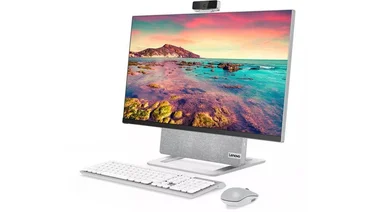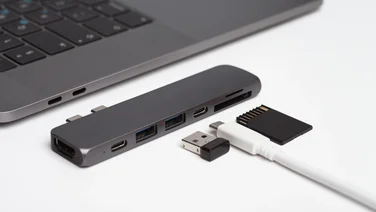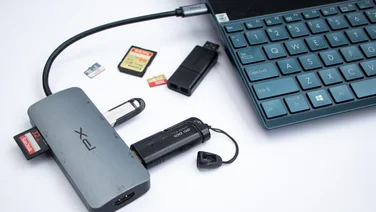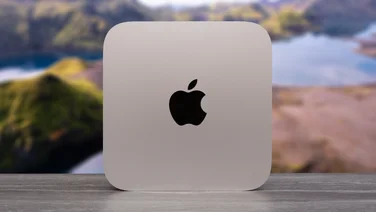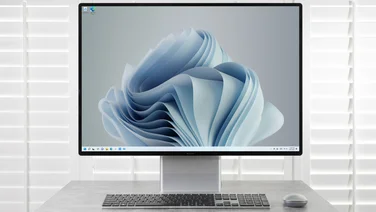To help us provide you with free impartial advice, we may earn a commission if you buy through links on our site. Learn more












- Compact and elegant
- Hugely powerful
- Runs extremely quiet
- No internal expandability
- Pricey
The 2023 Apple Mac Studio is one of those updates that would be easy to discount in passing. Its oversized Mac mini chassis, all built from recycled aluminium, might look pretty but nothing has changed since it was first announced in 2022. Yet it’s probably more interesting – for a certain type of person – than anything else Apple has announced this year. And, yes, that includes the Apple Vision Pro.
That’s because this year, it has been upgraded with Apple’s high-end M2 Ultra processor – an absolute monster of a chip that, Apple says, doubles the performance of the M1 Ultra. This is a chip that delivers 24 CPU cores, up to 76 GPU cores and a 32-core count for its Neural engine for a significant boost to overall performance.
READ NEXT: The best laptops you can buy today
Apple Mac Studio review (M2 Ultra, 2023): What you need to know
As with last year’s Mac Studio, the 2023 version is available in a number of different flavours and the performance level will be determined by the processor you choose.
You can either buy the Mac Studio with a 12-core M2 Max chip or the 24-core M2 Ultra, and within these two base models, there are various other options as to the number of GPU cores you can have. Naturally, you can also specify how much unified memory and SSD storage you want as well.
With the M2 Max Mac Studio, for instance, you can choose either a 30-core or a 38-core GPU, backed by either 32GB, 64GB or 128GB of RAM and up to an 8TB SSD. The M2 Ultra model, on the other hand, can be specified with either a 60- or 76-core GPU, backed by 64GB, 128GB or 192GB of RAM and (again) up to 8TB of SSD storage. The M2 Max comes with a 16-core Neural Engine while the M2 Ultra features a 32-core Neural Engine.

Now, you might have noticed a bit of a pattern developing over the previous paragraph or two – with the M2 Ultra all the numbers are precisely double those of M2 Max – and the explanation for this is fairly straightforward: the M2 Ultra is, essentially, two M2 Max chips stuck together. These are able to talk to each other over a 2.5TB/sec data link, a technology Apple calls UltraFusion.
The only other differences of significance between the M2 Max and M2 Ultra Mac Studio are the speed of the front-facing Thunderbolt ports (10Gbits/sec vs 40Gbits/sec) and the number of external displays supported (up to five versus up to eight, respectively).
Apple Mac Studio review (M2 Ultra, 2023): Price and competition
Configuration tested: M2 Ultra (24-core CPU, 76-core GPU, 32-core Neural Engine); 128GB RAM; 4TB SSD. Price: £6,999
The Mac Studio might look like a fat Mac mini but the target market is completely different. The Studio is a desktop computer aimed at digital creatives who need more horsepower than your average desktop user; it’s a professional tool, certainly at the top end of its power range, and it is priced accordingly.
With that in mind, it’s probably not surprising to find that the price of the Apple Mac Studio starts at a relatively high £2,099 with 32GB of RAM and a 512GB SSD. That’s not super silly money but, take note: this is only for the M2 Max model. If you want the M2 Ultra Mac Studio, your options start at £4,199 (64GB and 1TB) and that price can rise as high as £8,999 for the 76-core GPU model with 192GB of RAM and 8TB of SSD storage. I was sent a mid-weight M2 Ultra model to test for this review with 128GB of RAM and a 4TB SSD. This model costs £6,999.

There isn’t anything else that we regularly review that comes with this much raw power on tap, so it’s quite a challenge to pick a rival from products we’ve already reviewed. The closest machines we’ve tested in terms of raw power are high-powered gaming laptops such as this year’s Asus ROG Strix Scar 16 and Alienware M16 AMD machines and those are a long way behind the M2 Ultra Max Studio when it comes to raw computing power.
The most natural rivals are desktop workstation computers from the likes of HP, Dell and Armari, based on Intel’s Xeon and AMD’s Threadripper Pro CPUs. These PCs tend to be bigger and more power-hungry but the flip side is they offer far more flexibility and potential raw power with higher core counts and clock speeds, plus the ability to upgrade RAM and add PCIe expansion cards.
READ NEXT: The best laptops for students
Apple Mac Studio review (M2 Ultra, 2023): Design and key features
This section is going to be pretty short because the design is the area where nothing has changed in 2023. Even internally, the design and layout of the Mac Studio remains the same as it was the first time around.
That’s no bad thing, however, because the Mac Studio is the most attractive and elegantly designed workstation PC money can buy. In fact it shares the same desktop footprint as a Mac mini, measuring 197 x 197mm, and around two and a bit times the height (95mm vs 36mm).
In theory, it’s small enough to fit in a rucksack and carry from A to B but it is probably a bit heavy to do that with too often. The weight depends on which processor you choose: the lower power M2 Max Mac Studio requires only an aluminium heatsink to dissipate the heat generated by the processor and weighs 2.7kg, while the M2 Ultra employs a denser copper heatsink, adding nearly a kilo to the overall heft at 3.6kg.

Most of the rest of the cooling system is the same across both models, with a pair of large fans drawing air in at vents on the base and pushing it out of a large grille at the rear of the machine and, as with last year’s Mac Studio, these are super quiet. I’ve had the Mac Studio sat on my desk right next to my monitor less than a metre away for two weeks now and, no matter how heavy the workload, I’ve never been able to hear the fans over the background hum of the office air conditioning.
Whichever model you choose, you’re getting the same physical selection of connections, too. There are four 40Gbits/sec Thunderbolt 4 ports on the rear with support for DisplayPort plus one HDMI port, one 10Gbit/sec Ethernet port and a 3.5mm headphone jack. Fortunately, the latter is placed more sensibly than the one on the Mac mini, which is positioned immediately beneath the system’s two USB-A ports. The Mac Studio also has a pair of legacy 5Mbits/sec USB-A ports but here they’re orientated vertically, between the power input and HDMI 2.1 outputs.

The front of the Mac Studio looks identical on both versions but, as mentioned above, the specification is slightly different, with the Max’s two USB-C ports only stretching to 10GB/sec data transfer speeds and the Ultra reaching 40GB/sec. As for wireless, you’re getting the best of the best, with support for Wi-Fi 6E and Bluetooth 5.3.
The most disappointing aspect of this upgrade is that there’s no more expandability than on the first Mac Studio. Interestingly, the SSD storage comes installed on quick release proprietary modules. However, these don’t allow you to upgrade the storage, only swap out the drive for drives of the same size.
Apple Mac Studio review (M2 Ultra, 2023): Performance
As a quick reminder, this is a machine that’s firmly aimed at professional digital creatives. In other words, those who habitually edit and output 4K and 8K video tasks in their daily work, work in 3D modelling and or animation, complex scientific modelling and more. It is not, I stress, aimed at a lowly tech journalist, tapping out a few thousand words of copy a day – a job it is vastly overqualified for.
And the Mac Studio I’ve been sent for testing is among the most overqualified of the lot, with the 24-core M2 Ultra running at up to 3.5GHz equipped with a 76-core GPU, a 32-core Neural Engine and backed up with 128GB of unified memory. The M2 Ultra is, like last year, two M2 Max chips stuck together using Apple’s 2.5TB/sec UltraFusion connector so, in theory, it should offer up to double the speed of the cheaper M2 Max version.

It also represents quite the upgrade over last year’s M1 Ultra, which featured in the first Mac Studio I reviewed last year. The 2023 M2 Ultra has four more CPU cores, 16 more GPU cores (on the top model), and supports up to 192GB of RAM where the M1 only went up to 128GB. You’d expect a bump in performance and that certainly proved to be the case. It delivered a moderateå improvement of 15% in our in-house 4K media benchmarks, 16% in the Geekbench 5 single-core test and 18% in the Geekbench 5 multi-core test.

Its 76-core GPU is where the action is at this year, though, and this delivered significant gains across the benchmarks we ran. The Geekbench 5 OpenCL Compute benchmark revealed a 43% performance improvement while the GFXbench Car Chase test (also an OpenCL-based test) showed a 46% performance improvement.

This is important because, if any, this was an area of weakness last year. It’s still no match for computers equipped with the likes of Nvidia’s GeForce RTX 40-series GPUs, as suggested in the Geekbench 5 Compute chart below but it is a lot closer to the GeForce RTX 30-series machines (such as the 3080 Ti-based Alienware x17 R2) than it was last year.

Another area of improvement is storage, where we see more small improvements in both sequential read and write rates at 5,781MB/sec and 6,804MB/sec respectively.

It’s clearly a very fast machine, but how does that compare with Windows based workstations? You might assume that, being an Apple device, you’d be paying a premium but that’s not necessarily the case.
Pop over to the Amari website – a highly regarded UK workstation specialist – and specify something similar in performance terms and you’ll be paying roughly the same price. A Magnetar X64TP-AW2000G3 machine built around a 32-core AMD Threadripper Pro 5975WX CPU, an Nvidia RTX A4000 GPU, 128GB of DDR4-3200 ECC RAM and 4TB of SSD storage will set you back £7,545 at the time of writing.
In the meantime, A Dell Precision 7920 workstation, equipped with a 12-core, 24-thread Intel Xeon Gold 6256 CPU, an Nvidia RTX A4000 GPU, 128GB of 2,933MHz ECC RAM and 4TB of SSD storage makes the Mac Studio look even better value for money at £10,805.
READ NEXT: The best 2-in-1 laptops to buy today
Of course, you don’t have to spend this much if you’re willing to forgo the professional level graphics and CPU. For example, a workstation machine from Armari based on the 13th Gen 16-core, 32-thread Intel Core i9-13900KF CPU, with 64GB of RAM and a top-of-the-range Nvidia GeForce RTX 4090 GPU with 24GB of vRAM and a 4TB SSD, costs a mere £4,548. This particular machine can’t be specified at the point of sale with 128GB of RAM but you can bring it up to the same level as the Mac Studio with another pair of 32GB RAM modules for £169 from box.co.uk.
These are just three examples but what they indicate is that evaluating any machine like the Mac Studio on a performance per pound basis is rather difficult. On the one hand, it compares favourably to proper professional Windows workstations. On the other, you can get a far faster machine by using “consumer grade” components.
Where none of these machines can compete with the Mac Studio, however, is its sheer elegance of design, its compact size and its quietness.
Apple Mac Studio review (M2 Ultra, 2023): Verdict
That means my verdict for the 2023 Mac Studio is very much the same as last year. If you need a desktop computer that will take pretty much any task in its stride and you value quietness, neatness and elegance over expandability and sheer value for money, then it’s pretty much the perfect machine.
It delivers even more performance than last year’s Mac Studio, with a significant bump in graphics capabilities and in the same gloriously minimalist chassis. That is an achievement that shouldn’t be underestimated.


